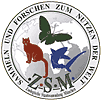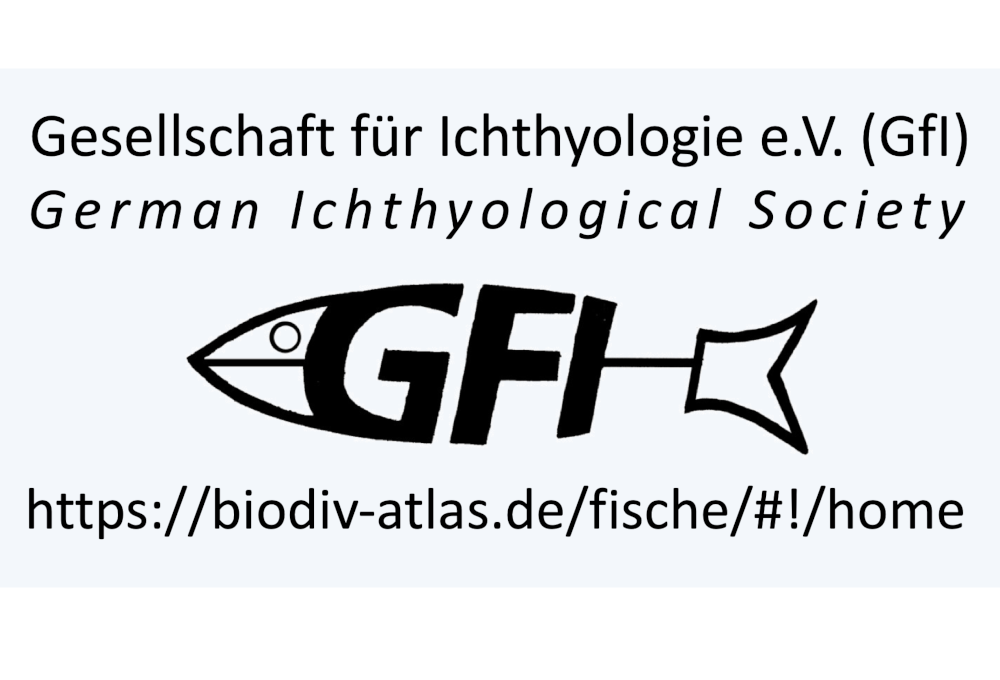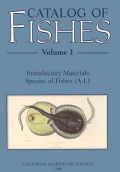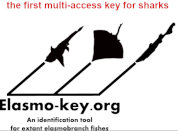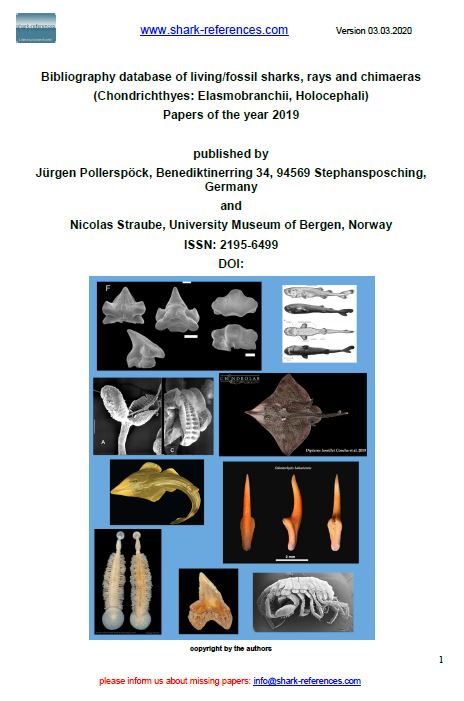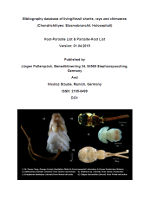A novel, nonlethal liver biopsy procedure in an elasmobranch. Australian Veterinary Journal, 103(7), 407–410
DOI: 10.1111/avj.13432
Heterochrony and Oophagy Underlie the Evolution of Giant Filter-Feeding Lamniform Sharks. Evolution & Development, 27(1), Article e.12496
DOI: 10.1111/ede.12496
The costs and healing rates of minor injuries in neonatal reef sharks. Journal of Fish Biology, 106(6), 1777–1788
DOI: 10.1111/jfb.16059
Catch Data Can Unravel Elasmobranch Aggregation Dynamics and Group Behaviours. Ecology and Evolution, 15(4), Article e71107
DOI: 10.1002/ece3.71107
Opportunities to enhance conservation success for sharks. npj Ocean Sustainability, 4, Article 24
DOI: 10.1038/s44183-025-00131-8
Tonic immobility in cartilaginous fishes (Chondrichthyes): function, evolutionary history, and future directions. Reviews In Fish Biology and Fisheries, in press
DOI: 10.1007/s11160-025-09958-3
A blacktip's black tip: The reliability of using dorsal-fin patterns for photo identification of blacktip reef sharks (Carcharhinus melanopterus). Journal of Fish Biology, in press
DOI: 10.1111/jfb.70114
The geometry of life: testing the scaling of whole-organism surface area and volume using sharks. Royal Society Open Science, 12(6), Article 242205
DOI: 10.1098/rsos.242205
Sexual Size Dimorphism in Rays and Skates (Elasmobranchii: Batoidea). Ecology and Evolution, 15(7), Article e71858
DOI: 10.1002/ece3.71858
Safety in the shallows: nearshore coastal habitats can provide physical and thermal features that optimize escape performance in newborn blacktip reef sharks (Carcharhinus melanopterus). Conservation Physiology, 13(1), Article coaf045
DOI: 10.1093/conphys/coaf045
Euryhaline Atlantic stingray (Hypanus sabinus) exhibit elevated oxygen supply capacity in hyposaline water: implications for estuarine species resilience and conservation. Conservation Physiology, 13(1), Article coaf071
DOI: 10.1093/conphys/coaf071

Spatial and temporal analysis of juvenile blacktip reef shark (Carcharhinus melanopterus) demographies identifies critical habitats. Journal of Fish Biology, 104(1), 92–103
DOI: 10.1111/jfb.15569
Evidence of dystocia in an oviparous shark. Journal of Fish Biology, 105(3), 1004–1007
DOI: 10.1111/jfb.15819
The lunar cycle does not influence catch rates or foraging success of neonatal reef sharks in an amphidromic nursery system. Coral Reefs, 43(5), 1249–1258
DOI: 10.1007/s00338-024-02534-4
Vulnerability of Eastern Tropical Pacific chondrichthyan fish to climate change. Global Change Biology, 30(7), Article e17373
DOI: 10.1111/gcb.17373
Novel use of deep neural networks on photographic identification of epaulette sharks (Hemiscyllium ocellatum) across life stages. Journal of Fish Biology, 105(6), 1572–1587
DOI: 10.1111/jfb.15887
No effects of abiotic and anthropogenic factors on reef-associated neonate shark abundance within a shark nursery-area system. Marine and Freshwater Research, 75(14), Article Mf24080
DOI: 10.1071/mf24080
How hot is too hot? Thermal tolerance, performance, and preference in juvenile mangrove whiprays, Urogymnus granulatus. Journal of Thermal Biology, 124, Article 103943
DOI: 10.1016/j.jtherbio.2024.103943
5 | Threats In R.W. Jabado, A.Z.A. Morata, R.H. Bennett, B. Finucci, J.R. Ellis, S. Fowler, M.I. Grant &. A.P. Barbosa Martins, S.L. Sinclair (Eds.), The global status of sharks, rays, and chimaeras (pp. 75–86). International Union for Conservation of Nature and Natural Resources.
DOI: 10.59216/ssg.gsrsrc.2024
Nonlethally assessing elasmobranch ontogenetic shifts in energetics. Journal of Fish Biology, 103(2), 235–246
DOI: 10.1111/jfb.15425

Effects of projected end-of-century temperature on the muscle development of neonate epaulette sharks, Hemiscyllium ocellatum. Marine Biology, 170(6), Article 71
DOI: 10.1007/s00227-023-04218-z
Sharks and their relatives: can their past help predict their future? Frontiers in Marine Science, 10, Article 1268532
DOI: 10.3389/fmars.2023.1268532
Quantifying changes in umbilicus size to estimate the relative age of neonatal blacktip reef sharks (Carcharhinus melanopterus). Conservation Physiology, 11(1), Article coad028
DOI: 10.1093/conphys/coad028
Genetic evidence for plastic reproductive philopatry and matrotrophy in blacktip reef sharks (Carcharhinus melanopterus) of the Moorea Island (French Polynesia). Scientific Reports, 13(1), Article 14913
DOI: 10.1038/s41598-023-40140-6
A multi-tasking stomach: functional coexistence of acid-peptic digestion and defensive body inflation in three distantly related vertebrate lineages. Biology Letters, 18(2), Article 20210583
DOI: 10.1098/rsbl.2021.0583

Thermally insensitive physiological performance allows neonatal sharks to use coastal habitats as nursery areas. Marine Ecology Progress Series, 682, 137–152
DOI: 10.3354/meps13941

Aquatic Walking and Swimming Kinematics of Neonate and Juvenile Epaulette Sharks. Integrative and Comparative Biology, 62(6), 1710–1724
DOI: 10.1093/icb/icac127
Diel Rhythm and Thermal Independence of Metabolic Rate in a Benthic Shark. Journal of Biological Rhythms, 37(5), 484–497
DOI: 10.1177/07487304221107843
The upper thermal limit of epaulette sharks (Hemiscyllium ocellatum) is conserved across three life history stages, sex and body size. Conservation Physiology, 10(1), Article coac074
DOI: 10.1093/conphys/coac074
Escape response kinematics in two species of tropical shark: short escape latencies and high turning performance. Journal of Experimental Biology, 225(22), Article jeb243973
DOI: 10.1242/jeb.243973

Population variation in the thermal response to climate change reveals differing sensitivity in a benthic shark. Global Change Biology, 27(1), 108–120
DOI: 10.1111/gcb.15422

Regulate or tolerate: Thermal strategy of a coral reef flat resident, the epaulette shark, Hemiscyllium ocellatum. Journal of Fish Biology, 98(3), 723–732
DOI: 10.1111/jfb.14616
Future thermal regimes for epaulette sharks (Hemiscyllium ocellatum): growth and metabolic performance cease to be optimal. Scientific Reports, 11, Article 454
DOI: 10.1038/s41598-020-79953-0

Investigating links between thermal tolerance and oxygen supply capacity in shark neonates from a hyperoxic tropical environment. Science of the Total Environment, 782, Article 146854
DOI: 10.1016/j.scitotenv.2021.146854

A lack of red blood cell swelling in five elasmobranch fishes following air exposure and exhaustive exercise. Comparative Biochemistry and Physiology – Part A, Molecular & Integrative Physiology, 258, Article 110978
DOI: 10.1016/j.cbpa.2021.110978
Elasmobranch Responses to Experimental Warming, Acidification, and Oxygen Loss-A Meta-Analysis. Frontiers in Marine Science, 8, Article 735377
DOI: 10.3389/fmars.2021.735377

Simulated heatwave and fishing stressors alter corticosteroid and energy balance in neonate blacktip reef sharks, Carcharhinus melanopterus. Conservation Physiology, 9, Article coab067
DOI: 10.1093/conphys/coab067

Anthropogenic stressors influence reproduction and development in elasmobranch fishes. Reviews in Fish Biology and Fisheries, 30, 373–386
DOI: 10.1007/s11160-020-09604-0

Home range of newborn blacktip reef sharks (Carcharhinus melanopterus), as estimated using mark-recapture and acoustic telemetry. Coral Reefs, 39, 1209–1214
DOI: 10.1007/s00338-020-01965-z

Responses of a coral reef shark acutely exposed to ocean acidification conditions. Coral Reefs, 39, 1215–1220
DOI: 10.1007/s00338-020-01972-0

Thermal tolerance and hypoxia tolerance are associated in blacktip reef shark (Carcharhinus melanopterus) neonates. Journal of Experimental Biology, 223(14), Article jeb221937
DOI: 10.1242/jeb.221937
The power struggle: assessing interacting global change stressors via experimental studies on sharks. Scientific Reports, 10, Article 19887
DOI: 10.1038/s41598-020-76966-7

Estimating oxygen uptake rates to understand stress in sharks and rays. Reviews in Fish Biology and Fisheries, 29(2), 297–311
DOI: 10.1007/s11160-019-09553-3
Same species, different prerequisites: investigating body condition and foraging success in young reef sharks between an atoll and an island system. Scientific Reports, 9, Article 13447
DOI: 10.1038/s41598-019-49761-2
Analysing tropical elasmobranch blood samples in the field: blood stability during storage and validation of the HemoCue® haemoglobin analyser. Conservation Physiology, 7, Article coz081
DOI: 10.1093/conphys/coz081

Absence of cellular damage in tropical newly hatched sharks (Chiloscyllium plagiosum) under ocean acidification conditions. Cell Stress and Chaperones, 23(5), 837-846
DOI: 10.1007/s12192-018-0892-3

Too hot to handle? Using movement to alleviate effects of elevated temperatures in a benthic elasmobranch, Hemiscyllium ocellatum. Marine Biology, 165(11), Article 162
DOI: 10.1007/s00227-018-3427-7
Dead tired: evaluating the physiological status and survival of neonatal reef sharks under stress. Conservation Physiology, 6, Article coy053
DOI: 10.1093/conphys/coy053

Distribution patterns of ocellated eagle rays, Aetobatus ocellatus, along two sites in Moorea Island, French Polynesia. Cybium, 42(4), 313–320
DOI: 10.26028/cybium/2018-424-002

Biological responses of sharks to ocean acidification. Biology Letters, 13(3), Article 20160796
DOI: 10.1098/rsbl.2016.0796

Validation of a portable, waterproof blood pH analyser for elasmobranchs. Conservation Physiology, 5, Article cox012
DOI: 10.1093/conphys/cox012

Foraging behaviour of the epaulette shark Hemiscyllium ocellatum is not affected by elevated CO2. ICES Journal of Marine Science, 73(3), 633–640
DOI: 10.1093/icesjms/fsv085

Developing in warm water: irregular colouration and patterns of a neonate elasmobranch. Marine Biodiversity, 46(4), 743–744
DOI: 10.1007/s12526-015-0429-2

DNA barcoding supports the presence of the cryptic ocellated eagle ray, Aetobatus ocellatus (Myliobatidae), in French Polynesia, South Pacific. Cybium, 40(2), 181–184
Will ocean acidification affect the early ontogeny of a tropical oviparous elasmobranch (Hemiscyllium ocellatum)? Conservation Physiology, 4, Article cow003
DOI: 10.1093/conphys/cow003

Blacktip reef sharks (Carcharhinus melanopterus) show high capacity for wound healing and recovery following injury. Conservation Physiology, 3, Article cov062
DOI: 10.1093/conphys/cov062

Validation of the i-STAT system for the analysis of blood gases and acid-base status in juvenile sandbar shark (Carcharhinus plumbeus). Conservation Physiology, 3, Article cov002
DOI: 10.1093/conphys/cov002
A product of its environment: the epaulette shark (Hemiscyllium ocellatum) exhibits physiological tolerance to elevated environmental CO2. Conservation Physiology, 2, Article cou047
DOI: 10.1093/conphys/cou047

Juvenile Ribbontail Stingray, Taeniura lymma (Forsskål, 1775) (Chondrichthyes, Dasyatidae), demonstrate a unique suite of physiological adaptations to survive hyperthermic nursery conditions. Hydrobiologia, 701(1), 37–49
DOI: 10.1007/s10750-012-1249-z
